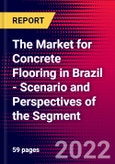This report aims to update information on products and services involved in the concrete flooring production chain, as well as serving as a strategic tool to support the joint growth of all companies involved in the sector.
With the last survey being carried out in 2012, the study rescued the period from 2015 to 2021 and Forecasts until 2026.
The sector's challenges have been enormous in the last 5 years due to the efforts of civil construction to resume growth in the post “Lava Jato” gate period, where the economic environment was unstable, with high interest rates, strong exchange rate devaluation, galloping inflation, resulting in high input prices, not to mention the recent occurrence of the pandemic, the troubled international scenario of the War between Russia and Ukraine, in addition to the recent increases in interest rates in most developed countries, mainly in the USA.
The reduction in household consumption in the last 2 years resulted in a greater focus on basic and priority consumer goods such as: food, beverages, clothing, hygiene/cleaning products, pharmaceuticals, and construction materials for renovations, promoting business in productive industries to these chains and mainly stimulating online retail and wholesale trade.
This exponential increase in purchases via e-commerce caused by the pandemic aroused the need for investments in expansions and renovations in the industrial sector, storage services, distribution center, logistics, and supermarkets.
With the need for expansion and improvements in the industrial / logistics sector to meet the demands of e-commerce and, on the other hand, the containment of investments, mainly in the first half of 2020, caused by outbreaks of the pandemic, resulted in a significant resumption of the concrete flooring business in 2021, with positive consequences for the coming years.
It is also worth mentioning the advances in agribusiness due to exports of commodities that demanded investments in seaports, and expansion of the grain processing and storage industries.
We can also observe in the last 5 years, an evolution in industrialized construction techniques, prefabricated whether in concrete, steel or hybrid; as well as in the advancement of sustainable materials, in the use of additives, hardeners, and other raw materials that increase resistance and productivity of concrete floors among other maintenance solutions.
In the scenario of technical projects, we highlight the search for BIM (Building Information Modeling) technology and the greater demand for project offices, demonstrating the strength of the formal market. There has been a considerable increase in the search for solutions that generate gains in technical performance and cost reduction possibilities. On the other hand, we also must consider the large number of informal floors, mainly concentrated in smaller than 1,000m2 constructions that did not require specific engineering projects for floors and used mostly their own labor or non-specialized autonomous services.
Given the acceleration of industrial construction business, especially in 2021, an increase in the number of flooring applicator / executor companies was noticed, which spread even further across the country in search of capturing demands in regional growth.
Thus, the concrete flooring sector follows its course of increasing its investments in product technology, equipment and services, improving quality and mainly promoting the formality of projects that will remain a great challenge for the sector.
The future will be one of great challenges due to the unknowns resulting from the pandemic, the new Government, and the “unfolding” of the troubled external market that puts pressure on the availability and prices of inputs, which consequently undermine the competitiveness of the sector, in addition to the challenges of growth of industrial construction in the residential and agribusiness sectors.
Let's take a ride on the Construa Brasil Program launched in 2022 to support the development of industrialized construction including concrete floors, with the aim of reducing bureaucracy and stimulating the modernization of civil construction, expanding the viability of business for everyone.
Table of Contents
1. Introduction2. Overview of objectives and audiences








